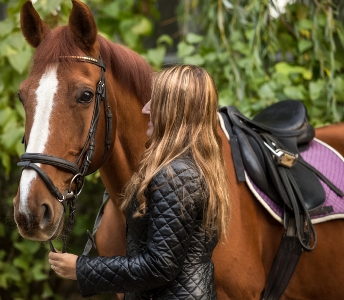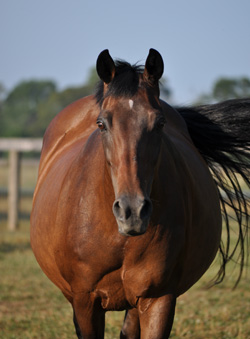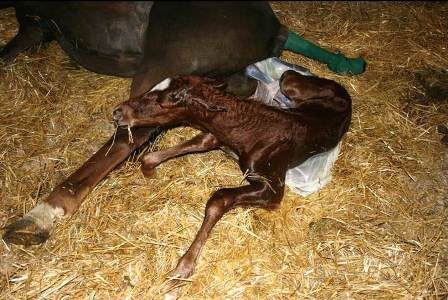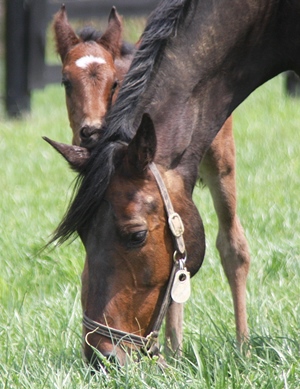 Knowing when to stop riding your pregnant broodmare can be a debatable topic. This article will review recommended time points yet, like an individual person, each broodmare has independent feelings and each pregnancy can be different for a particular broodmare. There are noticeable signs your broodmare may be showing you she is uncomfortable or physically unable to do certain movements you ask of her when riding. It is always recommended that you consult your veterinarian when deciding the best plan of action regarding riding your broodmare and how strenuous the activity should be.
Knowing when to stop riding your pregnant broodmare can be a debatable topic. This article will review recommended time points yet, like an individual person, each broodmare has independent feelings and each pregnancy can be different for a particular broodmare. There are noticeable signs your broodmare may be showing you she is uncomfortable or physically unable to do certain movements you ask of her when riding. It is always recommended that you consult your veterinarian when deciding the best plan of action regarding riding your broodmare and how strenuous the activity should be.
Before Pregnancy
Every horse should be in their optimal range for a body condition score. You can see more information about feeding mares for optimal conception and body score conditions in our article Feeding For Conception. More importantly a broodmare should be healthy and have regular conditioning work before a pregnancy. By doing so, her muscles will have the ideal fitness they need to carry a pregnancy. An obese broodmare is going to have a difficult pregnancy since she already has too much weight bearing on her joints even before she becomes pregnant. The added weight of the placenta and foal will become quite overbearing for her to carry which could lead to other health risks.
In the opposite direction, the underweight broodmare may have a difficult time conceiving or keeping the pregnancy. This can apply to the embryo transfer (ET) mare in training as well. For more information about what to consider when riding the ET donor mare please read our article, Balancing the Show and Breeding Careers of an Embryo Transfer Donor Mare.
Depending on how fit the broodmare is before her pregnancy will also determine how quickly she recuperates after her pregnancy. Broodmares that are fit before and during their pregnancy have a much quicker recovery time than those who had poor fitness.
During Pregnancy
 It is crucial to remember that at no point should the health of the mare or foal be compromised. Riding activities should not be extremely strenuous as to cause additional stress which could lead to pregnancy loss. Also, over exertion in hot weather or high humidity could result in dehydration or heat exhaustion. Either of these conditions will put both the mare and foal at risk. It seems to be a widely accepted rule that riding a broodmare for her first 6-8 months of pregnancy is okay and can even be beneficial. Dr. Dave Scofield of SBS Veterinary Services said,
It is crucial to remember that at no point should the health of the mare or foal be compromised. Riding activities should not be extremely strenuous as to cause additional stress which could lead to pregnancy loss. Also, over exertion in hot weather or high humidity could result in dehydration or heat exhaustion. Either of these conditions will put both the mare and foal at risk. It seems to be a widely accepted rule that riding a broodmare for her first 6-8 months of pregnancy is okay and can even be beneficial. Dr. Dave Scofield of SBS Veterinary Services said,
"I advise clients to treat their mares normally through the first six months of pregnancy. Light work, training, and travel are all ok for the mares during early and mid gestation. I advise clients to stay away from putting the mare in a complete full sweat. This means that a rider has to balance the level of activity for a certain period of time and, more importantly, consider ambient temperature and humidity to prevent overheating the mare."
There are many positive and negatives to riding a broodmare who is confirmed pregnant. The positive attributes often occur in the early stages of pregnancy. Since the broodmare no longer has an estrus cycle for the duration of her pregnancy, the difficult or temperamental mares may become quite enjoyable without the constant mood swings. This may even lead to quicker advancement in competition levels or willingness of movements. Also, interactions between other horses may become more tolerable and less defensive which leads to a more focused connection between the mare and her rider, whether it is ground work or riding.
The negative attributes often come later in the pregnancy towards seven or eight months. The broodmare might become less accepting of work since she is starting to become physically uncomfortable. Bending may become more difficult and there may be reluctance to collect. Unfortunately, the saddle or other tack may not fit correctly since her body is changing which may also lead to different and painful pressure points. The additional weight from the foal already requires the mare to adjust her balance and coordination, adding a person on her back will only interfere more. Simple conditioning with many straight movements and frequent walk breaks will be much easier and appreciated by the expecting mother. If possible, in the 8th month of her term riding bareback for short hacks might be the best situation for her physical state.
Since the foal does most of its growing in the last trimester, the abdomen of the mare will be at its largest. Reducing riding activity at this point is highly recommended. However, allowing adequate space, like a large pasture for the broodmare to move around in is essential. Allowing continuous movement will help reduce fluid retention and will aid in circulation.
 The last 6 weeks before birth the broodmare should have “off”. Continue to allow her turnout in her large pasture so she can continue to move. In other words, it is recommended to not require her to do any strenuous activity other than what she feels comfortable doing on her own.
The last 6 weeks before birth the broodmare should have “off”. Continue to allow her turnout in her large pasture so she can continue to move. In other words, it is recommended to not require her to do any strenuous activity other than what she feels comfortable doing on her own.
Post-Pregnancy
When deciding an appropriate time to put your broodmare back to work there are several factors to consider. This list includes but is not limited to; the birthing experience, physical changes, and your weaning plan.
The birthing experience for your mare may be uncomplicated or it could result in excessive bleeding, tearing, a retained placenta, or an infection. Understandably one or several of these complications are more severe than others. Nonetheless, it will affect the mare going back to riding work.
In addition to the birthing experience several physical changes occur in the broodmare such as accumulation of fluid, particularly in the lower legs and belly, will take time to disperse. Before the foal was born it took up a large space in the mare’s abdomen forcing her internal organs to become slightly displaced from their original position. Once the foal is born and the large cavity is still there, the internal organs will take a few weeks to return back to their pre-foal location.
Generally, the mare will need time to recuperate after giving birth. Providing adequate time for the mare to heal and being observant of her actions will help guide the time frame for her “ready to work schedule”.
 How quickly you wish to return your broodmare to work once she has physically healed will also be dependent on how you choose to deal with weaning the foal. If the foal is still nursing and the decision has been made to put the mare back to work there are a few ways to handle the anxious mare and foal. Completely separating the mare and the foal will be unfavorable, even for just a few moments. The mare will become distracted and stressed making the riding or ground work unproductive. Instead, riding or working with the mare in an enclosed arena will allow the foal to be at the mare’s side. If this situation is worrisome, try having a “babysitter” for the foal while the mare is gone. The foal and mare should be comfortable with said babysitter; generally gentle geldings are perfect for the job.
How quickly you wish to return your broodmare to work once she has physically healed will also be dependent on how you choose to deal with weaning the foal. If the foal is still nursing and the decision has been made to put the mare back to work there are a few ways to handle the anxious mare and foal. Completely separating the mare and the foal will be unfavorable, even for just a few moments. The mare will become distracted and stressed making the riding or ground work unproductive. Instead, riding or working with the mare in an enclosed arena will allow the foal to be at the mare’s side. If this situation is worrisome, try having a “babysitter” for the foal while the mare is gone. The foal and mare should be comfortable with said babysitter; generally gentle geldings are perfect for the job.
Once you have weaned the foal, putting the mare back to her conditioning work may be the best option for her. It will help ease her mind for the time being while coping with the absence of her foal. For additional information on the weaning process please see our articles; Care of the Weanling Foal, Taking the Stress Out of Weaning, and Feeding Decisions for Weanlings.
Riding your broodmare before, during, and after her pregnancy is extremely beneficial for her conditioning. Each broodmare must be evaluated on an individual basis during their pregnancy to know what level of physical activity is required. When creating a conditioning strategy for your broodmare it is best to always consult your veterinarian. Be aware of physical and temperament changes your mare offers to you, whether subtle or blatant.
See Also:
Care and Vaccination of the Pregnant Mare
Photo Credit: Foal nibbling mare's ear taken by Phoebe Devoe-Moore


Log in to join the conversation.